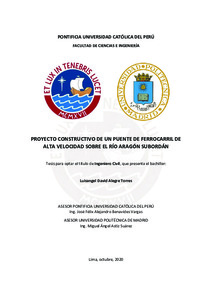Proyecto constructivo de un puente de ferrocarril de alta velocidad sobre el río Aragón Subordán
Abstract
El presente trabajo tuvo como objetivo el diseño de un puente de ferrocarril de alta
velocidad para salvar el río Aragón Subordán en el distrito de Puente la Reina de Jaca en la
provincia de Huesca en una extensión de poco menos de 1000 metros; para cumplir con dicho
propósito se realizó, en primer término, un estudio de los distintos condicionantes que presenta
el proyecto en dicho emplazamiento, se incluyeron en este los estudios topográficos,
geotécnicos, hidrológicos e hidráulicos; así como los condicionantes en cuanto al trazado y en
cuanto a las acciones que se aplicarán sobre la estructura, puesto que existirán cargas dinámicas
ferroviarias. Una vez ejecutados todos los estudios previamente mencionados se evaluaron tres
alternativas de puentes, un puente de sección cajón de hormigón, un puente con tramos
extradosados y tramos de sección cajón de hormigón, y un puente de sección cajón mixta. Se
realizó un análisis multicrtiterio para definir la solución más conveniente.
Se optó por el puente de sección cajón de hormigón por su precio menor comparado al
resto de alternativas, y por su facilidad constructiva debido a que el tablero será empujado
desde uno de los márgenes del río. Este puente se caracteriza por tener una longitud de vanos
de 57.0m y un canto constante de 3.74m simplemente apoyado sobre pilas y estribos. A
continuación, se realizó el análisis estructural, en donde, se destaca el análisis dinámico del
puente frente a las acciones del tren ferroviario. Más adelante, se realizó el diseño de la
armadura activa, la cual se divide en dos fases, una para la construcción y otra para las cargas
de servicio; y el diseño de las armaduras pasivas de los distintos elementos que conforman la
estructura (pilotes, zapatas, encepados, estribos y pilas), con especial atención en la solución
para hacer frente a las acciones horizontales longitudinales de viento y frenado; se decidió, en
este sentido, por tener un único punto fijo ubicado en el estribo oeste, el cual se conecta a una
viga de anclaje que transmitirá los esfuerzos al terreno del trasdós, esto exigió un análisis de la
estabilidad global de dicho elemento. Finalmente se realizaron las comprobaciones de
fisuración, deformaciones y vibraciones de la estructura para garantizar la seguridad de esta y
el confort de los usuarios. The aim of this project was the design of a high-speed railway bridge to cross the Aragón
Subordán river in the Puente la Reina de Jaca district in the province of Huesca, in a length of
almost 1000 meters; in order to fulfill this purpose, a set of studies was previously carried out
about the different conditioning factors that the project presents at the emplacement.
Topographic, geotechnical, hydrological and hydraulic studies were included; as well as the
conditioning factors regarding the layout and the actions that will be applied to the structure,
since there will be dynamic railway loads. Once all the aforementioned studies had been carried
out, three bridge alternatives were evaluated: a concrete caisson section bridge, a bridge which
is extradosed on the river bed and concrete caisson section on the river banks, and a composite
caisson section bridge. A multi-criteria analysis was performed to define the most convenient
solution.
The concrete caisson section bridge was chosen for its lower price compared to the rest of
the alternatives, and for its ease of construction due to the fact that the deck will be pushed
from one of the river banks. This bridge is characterized by having a span length of 57.0m and
a constant depth of 3.74m simply supported on piers and abutments. Later, the structural
analysis was carried out, where the dynamic analysis of the bridge stands out, due to the loads
of the railway train. Next, the design of the active reinforcement was made, which is divided
into two phases, one for construction and the other for service loads; the design of the passive
reinforcements of the different elements that make up the structure (piers, footings, pile caps,
abutments and piles) was performed as well, with special attention to the solution to cope with
the longitudinal horizontal actions of wind and braking; it was decided, in this sense, to have a
unique fixed point located in the western abutment, which is connected to an anchor beam that
will transmit the efforts to the backfilling, this required an analysis of the global stability of
this element. Finally, the cracking, deformation and vibration verifications of the structure were
carried out to guarantee its safety and user comfort.
Temas
Puentes--Diseño y construcción--España
Puentes--Estructura
Ferrocarriles
Puentes--Estructura
Ferrocarriles
Para optar el título de
Ingeniero Civil
Collections
The following license files are associated with this item:






